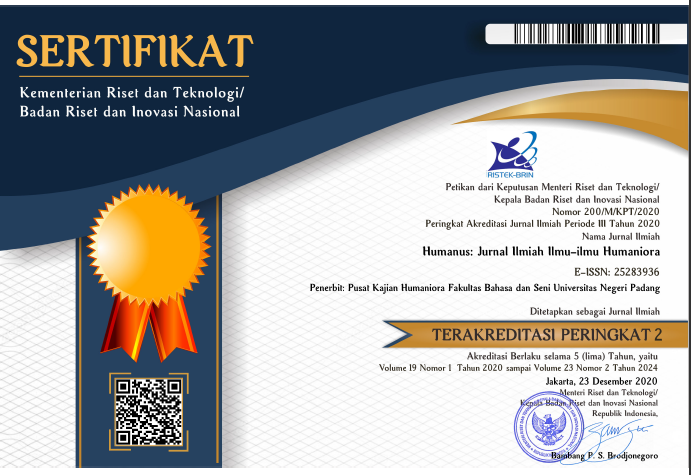Swear Words in French : Analysis of Social Class and Gender
 ),
), (1) Universitas Gadjah Mada
 Corresponding Author
Corresponding Author
Copyright (c) 2021 Humanus
DOI : https://doi.org/10.24036/humanus.v20i2.111969
Full Text:
 Language : en
Language : en
Abstract
Keywords
References
Ameri, S., & Ghazizadeh, K. (2014). A Norm-Based Analysis of Swearing Rendition in Professional Dubbing and Non-Professional Subtitling from English into Persian. Research in English Language Pedagogy, 2(2), 78–96. Retrieved from http://relp.khuisf.ac.ir/article_533615.html
Anggraini, D., & Himmawati, D. R. (2017). Translation Equivalence of Swearwords in The Walking Dead Comic. LANGUAGE HORIZON, 5(1), 100–108. Retrieved from https://jurnalmahasiswa.unesa.ac.id/index.php/language-horizon/article/view/20699
Bourdieu, P. (1984). La distinction: Critique sociale du jugement. Paris: Les Editions de Minuit.
Fakih, M. (2010). Analisis gender dan transformasi sosial (T. Rahardjo, Ed.). Yogyakarta: Pustaka Pelajar.
Flaubert, G. (1856). Madame Bovary. Paris: Revue de Paris.
Flaubert, G. (2016). Nyonya Bovary (W. Arifin, Trans.). Jakarta: Gramedia Pustaka Utama.
Hall, S. (1997). Representation: Cultural Representations and Signifying Practices. London: SAGE.
Hoed, B. H. (1993). Kala dalam novel: Fungsi dan penerjemahannya : sebuah kajian tentang penerjemahan Perancis-Indonesia. Yogyakarta: Gadjah Mada University Press. Retrieved from http://catalog.hathitrust.org/api/volumes/oclc/29486911.html
Holmes, J. (1995). An introduction to sociolinguistics. Harlow, Eng.; New York: Longman.
Karsana, D. (2015). Referensi dan Fungsi Makian dalam Bahasa Kaili. Metalingua, 13(2), 141–149. Retrieved from https://www.semanticscholar.org/paper/REFERENSI-DAN-FUNGSI-MAKIAN-DALAM-BAHASA-KAILI-AND-Karsana-Bahasa/70f2055a8fe2475817bf64a309aed517cbb498c8
KBBI. (2008). Kamus Besar Bahasa Indonesia (edisi 4). Jakarta: Gramedia Pustaka Utama. Retrieved from http://www.bukabuku.com/browses/product/9789792238419/kamus-besar-bahasa-indonesia-(edisi-4).html
Labov, W. (1976). Sociolinguistic Patterns. USA: University of Pennsylvania Press.
Lakoff, R. T. (1975). Language and woman’s place. New York; London: Harper and Row.
Mastoyo, Y. T. (2007). Pengantar (metode) penelitian bahasa. Yogyakarta: Carasvatibooks.
Rahimi, A. (2008). Syngué sabour pierre de patience. Paris: P.O.L.
Rahimi, A. (2013). Syngué sabour, pierre de patience [Drama, War]. The Film, Razor Film Produktion GmbH, Corniche Pictures.
Rahimi, A. (2016). Batu kesabaran: Singge sabur (F. I. Mokoginta, Trans.). Yogyakarta: Jalasutra.
Srivastava, K., Chaudhury, S., Bhat, P. S., & Sahu, S. (2017). Misogyny, feminism, and sexual harassment. Industrial Psychiatry Journal, 26(2), 111–113. https://doi.org/10.4103/ipj.ipj_32_18
Sudaryanto. (2015). Metode dan aneka teknik analisis bahasa: Pengantar penelitian wahana kebudayaan secara linguistis. Yogyakarta: Duta Wacana University Press.
Sumarsono, & Partana, P. (2002). Sosiolinguistik. Yogyakarta: Pustaka Pelajar.
Sunderland, J. (2006). Language and gender: An advanced resource book. London: Routledge.
Trudgill, P. (1974). Sociolinguistics: An introduction. Harmondsworth: Penguin.
Udasmoro, W. (2009). Pengantar Gender dalam Sastra. Yogyakarta: Fakultas Ilmu Budaya, Universitas Gadjah Mada.
Vitasari, I. (2013). Analysis On The Translation of Swear Words Produced By Two Main Characters In A very Harold And Kumar Christmas Movie. LANTERN (Journal on English Language, Culture and Literature), 2(2), 69–76. Retrieved from https://ejournal3.undip.ac.id/index.php/engliterature/article/view/2521
 Article Metrics
Article Metrics
 Abstract Views : 509 times
Abstract Views : 509 times
 PDF Downloaded : 265 times
PDF Downloaded : 265 times
Refbacks
- There are currently no refbacks.
Copyright (c) 2021 Humanus

This work is licensed under a Creative Commons Attribution-NonCommercial 4.0 International License.









